
- •Textbook Series
- •Contents
- •1 Definitions
- •Introduction
- •Abbreviations
- •Definitions
- •2 International Agreements and Organizations
- •The Chicago Convention
- •International Law
- •Commercial Considerations
- •Customs and Excise, and Immigration
- •International Obligations of Contracted States
- •Duties of ICAO Member States
- •Status of Annex Components
- •The International Civil Aviation Organization (ICAO)
- •The Organization of ICAO
- •Regional Structure of ICAO
- •Regional Structure and Offices
- •ICAO Publications
- •Other International Agreements
- •The Conventions of Tokyo, the Hague and Montreal
- •The Warsaw Convention
- •The Rome Convention
- •IATA
- •ECAC
- •EASA
- •Eurocontrol
- •World Trade Organization
- •Geneva Convention
- •EU Regulation 261/2004
- •Questions
- •Answers
- •3 Airworthiness of Aircraft
- •Introduction
- •Airworthiness
- •Questions
- •Answers
- •4 Aircraft Nationality and Registration Marks
- •Introduction
- •Nationality and Registration Marks
- •Certification of Registration
- •Aircraft Markings
- •Classification of Aircraft
- •Questions
- •Answers
- •5 Flight Crew Licensing
- •Introduction
- •Definitions
- •General Rules Concerning Licensing
- •Licences and Ratings for Pilots
- •Multi-crew Pilot Licence (MPL)
- •Instrument Rating (Aeroplane) (IR(A))
- •Instructor and Examiner Rating
- •JAR-FCL 3 Medical Requirements
- •Pilot Proficiency
- •EASA Theoretical Knowledge Examinations
- •Questions
- •Answers
- •6 Rules of the Air
- •History
- •Applicability of the Rules of the Air
- •General Rules
- •Visual Flight Rules
- •Instrument Flight Rules
- •Semi-circular Flight Level Rules and RVSM
- •Special VFR
- •Distress and Urgency Signals
- •Restricted, Prohibited or Danger Areas
- •Signals for Aerodrome Traffic
- •Marshalling Signals
- •Flight Deck Signals
- •Questions
- •Answers
- •Instrument Procedures
- •PANS OPS
- •Instrument Departure Procedures
- •Questions
- •Answers
- •8 Approach Procedures
- •Procedure Basics
- •Approach Procedure Design
- •Obstacle Clearance Altitude/Height
- •Operating Minima
- •Descent Gradients
- •Track Reversal and Racetracks
- •Missed Approach Segment and Procedure
- •Published Information
- •RNAV Approach Procedures based on VOR/DME
- •Questions
- •Answers
- •9 Circling Approach
- •Circling Approach
- •Questions
- •Answers
- •10 Holding Procedures
- •Holding Procedures
- •Entry Sectors
- •ATC Considerations
- •Obstacle Clearance
- •Questions
- •Answers
- •11 Altimeter Setting Procedure
- •Altimeter Setting Objectives
- •Transition
- •Phases of Flight
- •Questions
- •Answers
- •12 Parallel or Near-parallel Runway Operation
- •Safety
- •Runway Spacing
- •Questions
- •Answers
- •13 SSR and ACAS
- •Airborne Collision Avoidance System (ACAS)
- •Questions
- •Answers
- •14 Airspace
- •Introduction
- •Control Areas and Zones
- •Classes of Airspace
- •Required Navigation Performance (RNP)
- •Airways and ATS Routes
- •Questions
- •Answers
- •15 Air Traffic Services
- •Introduction
- •Air Traffic Control
- •ATC Clearances
- •Control of Persons and Vehicles at Aerodromes
- •The Flight Information Service
- •The Alerting Service
- •Procedures
- •Questions
- •Answers
- •16 Separation
- •Concept of Separation
- •Vertical Separation
- •Horizontal Separation
- •Radar Separation
- •Procedural Wake Turbulence Separation
- •Radar Wake Turbulence Separation
- •Visual Separation in the Vicinity of Aerodromes
- •Stacking
- •Questions
- •Answers
- •17 Control of Aircraft
- •Procedural ATC
- •Radar Control
- •Radar Identification
- •Radar Service
- •Aerodrome Control
- •Approach Control Service
- •Air Traffic Advisory Service
- •Aircraft Emergencies
- •Questions
- •Answers
- •18 Aeronautical Information Service (AIS)
- •Introduction
- •General
- •The Integrated Aeronautical Information Package
- •The Aeronautical Information Publication (AIP)
- •Notices to Airmen (NOTAM)
- •SNOWTAM
- •ASHTAM
- •Aeronautical Information Circulars (AICs)
- •Pre-flight and Post-flight Information
- •Questions
- •Answers
- •Introduction
- •Aerodrome Reference Code
- •Glossary of Terms
- •Aerodrome Data
- •Runways
- •Taxiways
- •Aprons
- •Questions
- •Answers
- •Requirements
- •Visual Aids for Navigation
- •Runway Markings
- •Taxiway Markings
- •Signs
- •Markers
- •Visual Docking Guidance Systems
- •Questions
- •Answers
- •21 Aerodrome Lighting
- •Aerodrome Lights
- •Approach Lighting Systems
- •Runway Lighting
- •Taxiway Lighting
- •Questions
- •Answers
- •22 Obstacle Marking and Aerodrome Services
- •Introduction
- •Visual Aids for Denoting Obstacles
- •Visual Aids for Denoting Restricted Use Areas
- •Emergency and Other Services
- •Other Aerodrome Services
- •Questions
- •Answers
- •23 Facilitation
- •Entry and Departure of Aircraft
- •Questions
- •Answers
- •24 Search and Rescue
- •Definitions and Abbreviations
- •Establishment and Provision of SAR Service
- •Co-operation between States
- •Operating Procedures
- •Questions
- •Answers
- •25 Security
- •Introduction
- •Objectives
- •Organization
- •Preventative Security Measures
- •Management of Response to Acts of Unlawful Interference
- •Further Security Information
- •Questions
- •Answers
- •26 Aircraft Accident and Incident Investigation
- •Introduction
- •Objective of Investigation
- •Investigations
- •Serious Incidents
- •EU Considerations
- •Questions
- •Answers
- •27 Revision Questions
- •Revision Questions
- •Answers
- •EASA Specimen Examination
- •Answers to Specimen EASA Examination
- •28 Addendum – EASA Part-FCL & Part-MED
- •Chapter Five. Flight Crew Licensing
- •European Aviation Safety Agency (EASA)
- •Licences
- •Ratings
- •Certificates
- •EASA Part-MED
- •29 Index

20 Aerodromes -Visual Aids, Markings and Signs
Signs
20.35 General Specification. Signs are provided on aerodromes to convey a mandatory instruction, information on a specific location or destination on a movement area, or to provide other information as required.
20.36 Characteristics. Signs shall be frangible. Those located near a runway or taxiway shall be sufficiently low to preserve clearance for propellers and the engine pods of jet aircraft. Signs shall be rectangular, with the longer side horizontal. The only signs on the movement area utilizing red shall be mandatory instruction signs. Signs showing numbers only refer to runways. Signs shall be reflective and/or illuminated when intended for use at night. Signs shall be illuminated when intended for use:
• In runway visual range conditions less than a value of 800 m, or
• At night in association with instrument runways, or
• At night in association with non-instrument runways where the code number is 3 or 4.
20.37 Mandatory Instruction Signs. A mandatory instruction sign is provided to identify the location beyond which an aircraft taxiing or vehicle shall not proceed unless authorized by the aerodrome control tower. Mandatory instruction signs include runway designation signs, category I, II and III holding position signs, taxi-holding position signs, road-holding position signs and NO ENTRY signs. A pattern “A” taxiholding position marking shall be supplemented at a taxiway/runway intersection or a runway/taxiway intersection with a runway designation sign. A pattern “B” taxi-holding position marking shall be supplemented with a category I, II or III holding position sign. A runway designation sign at a taxiway/runway intersection should be supplemented with a location sign in the outboard (farthest from the taxiway) position as appropriate. A NO ENTRY sign shall be provided when entry into an area is prohibited.
20.38 Locations of Signs. Signs are to be located in positions such that pilots (or vehicle drivers) are able to see the sign. Signs are not to be positioned so as to create hazards to aircraft. Signs are positioned as follows:
• A runway designation sign at a taxiway/runway intersection shall be located at least on the
|
|
left side of a taxiway facing the direction of approach to the runway. Where practicable, a |
|
20 |
|
||
|
runway designation sign shall be located on each side of the taxiway. |
||
|
|
||
-Aerodromes |
• |
A NO ENTRY sign shall be located at the beginning of the area to which the entrance is |
|
|
|||
|
|
prohibited at least on the left hand side of the taxiway as viewed by the pilot. Where |
|
Visual |
|
practicable, a NO ENTRY sign shall be located on each side of the taxiway. |
|
• |
A Category I, II or III holding position sign shall be located on each side of the holding |
||
Aids, |
|||
|
position marking facing the direction of the approach to the critical area. |
||
Markings |
|
||
• |
A taxi-holding position is to be located on the left-side of the taxiholding position facing |
||
|
|||
and |
|
the approach to the runway or ILS/MLS critical/sensitive area, as appropriate, and where |
|
|
practicable, on each side of the taxi-holding position. |
||
Signs |
|
||
|
|
404
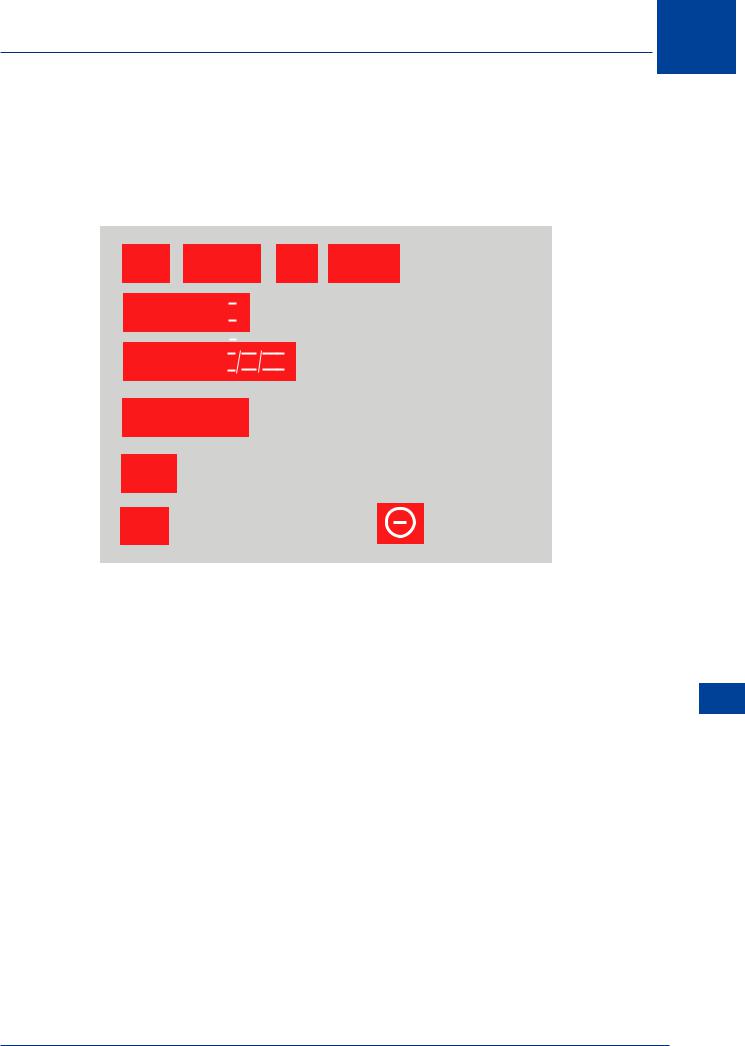
Aerodromes -Visual Aids, Markings and Signs 20
20.39 Characteristics. A mandatory instruction sign consists of white letters/numbers on a red background. The inscription on a runway designation sign consists of the runway designator. The inscription on a category I, II or III or joint II/III instrument approach holding position sign consists of the runway designator followed by CAT I, CAT II, CAT III, or CAT II/III, as appropriate. The inscription on a taxi-holding position sign shall consist of the taxiway designation and number.
27 09-27
27 CAT I
9 |
9-27 |
Visual holding point |
with single digit |
||
alternative (010 – 090) |
CAT I Instrument holding point
27 CAT I II III |
point |
|
||
|
|
|
CAT I/II/III Instrument holding |
|
15-APCH |
Taxi-holding point where approach to Runway 15 |
|||
passes over the taxiway |
|
|||
ILS |
May be used at a holding point instead of the CAT I II III signs |
|||
|
||||
B2 |
Intermediate taxi-holding point |
No Entry |
||
|
||||
Figure 20.14 Sign characteristics
Aerodromes - Visual Aids, Markings and Signs 20
405
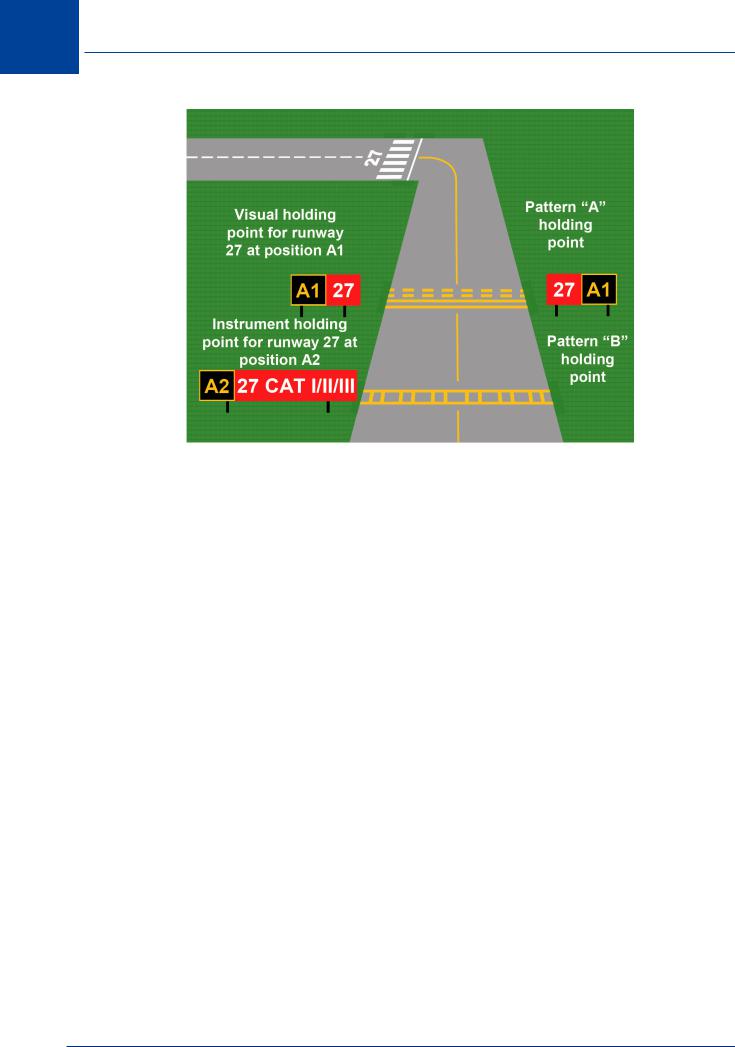
20 Aerodromes -Visual Aids, Markings and Signs
Figure 20.15 Information signs
20.40 Information Signs. Information signs are provided where there is an operational need to identify a specific location, or routing (direction or destination). Information signs include: direction signs, location signs, destination signs, runway exit signs and runway vacated signs. Wherever practicable, they are located on the left-hand side of the taxiway. At a taxiway intersection, information signs are located before the intersection and in line with the taxiway intersection marking. Runway exit signs are located on the same side of the runway as the exit is located (i.e. left or right). A runway vacated sign is located at least on one side of the taxiway to indicate when the aircraft is clear of the sensitive area. Where a runway vacated sign and a taxiway location sign are sited, the taxiway location sign is outboard of the runway vacated sign. A taxiway location sign installed in conjunction with a runway designation sign shall be positioned outboard of the runway designation sign. An information sign other than a location
|
sign shall not be collocated with a mandatory instruction sign. |
||
20 |
|||
|
|
||
|
20.41 Characteristics. The colour and symbology of information signs is as follows: |
||
Aerodromes |
|||
• |
Information Signs (except location signs), consist of an inscription in black on a yellow |
||
|
|||
Visual - |
|
background. |
|
• |
Location Signs consist of an inscription in yellow on a black background and where it is a |
||
Aids, |
|
stand alone sign, has a yellow border. |
|
Markings |
• |
arrow indicating the direction to follow. |
|
|
The inscription on a runway exit sign consists of the designator of the exit taxiway and an |
||
and |
• |
The inscription on a runway vacated sign depicts the pattern ‘A’ taxi-holding position |
|
Signs |
|||
|
marking. |
||
|
|
||
406
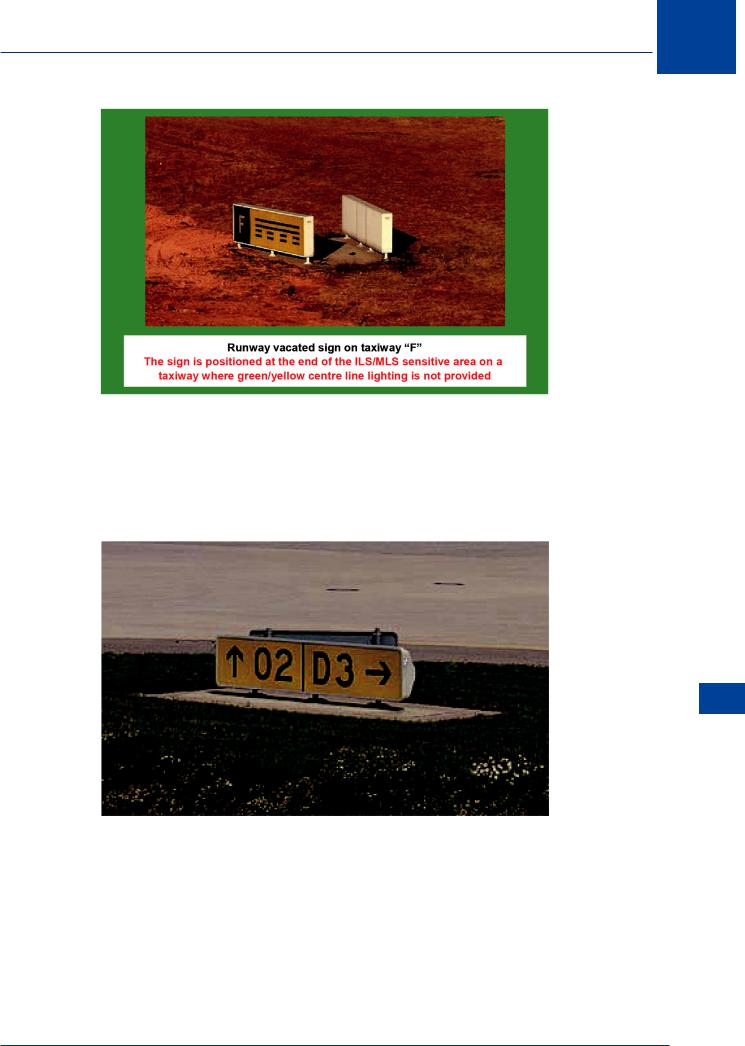
Aerodromes -Visual Aids, Markings and Signs 20
Figure 20.16 Runway vacated taxiway F
Note. A runway vacated sign also indicates that the aircraft is leaving the perimeter of the ILS/ MLS critical/sensitive area.
•The inscription on a destination sign identifies the destination with an arrow indicating the direction to proceed.
Figure 20.17 Runway 02 straight ahead: holding point D3 to the right
•The inscription on a direction sign identifies the taxiway(s) with an arrow (or arrows) appropriately orientated.
•The inscription on a location sign is the designation of the location taxiway, runway or other pavement the aircraft is on or is entering.
Note: Where it is necessary to identify each of a series of taxi-holding positions on the same taxiway, the location sign should consist of the taxiway designation and number.
Aerodromes - Visual Aids, Markings and Signs 20
407
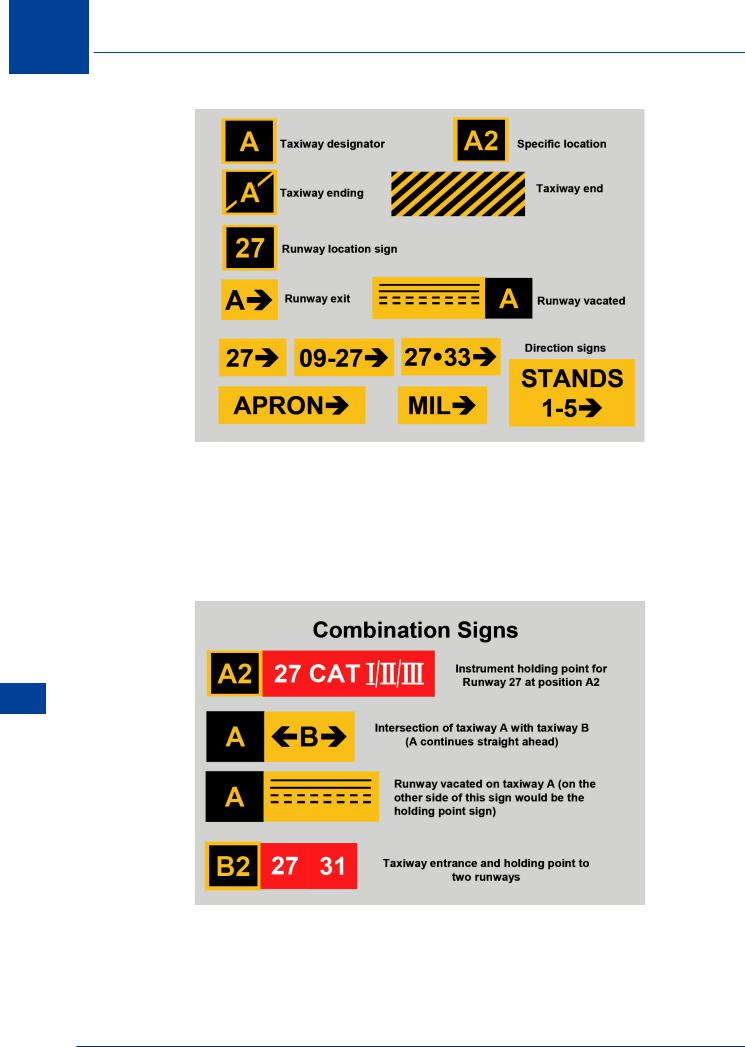
20 Aerodromes -Visual Aids, Markings and Signs
Signs and Markings Aids, Visual - Aerodromes 20
Figure 20.18
20.42 Combination Signs. Where a location sign and direction signs are used in combination, signs related to left turns are placed on the left side of the location sign and all direction signs related to right turns are placed on the right side of the location sign.
Exception: Where the junction consists of one intersecting taxiway, the location sign may be placed on the left hand side. Adjacent signs are delineated by a vertical black line.
Figure 20.19 Combination signs
408
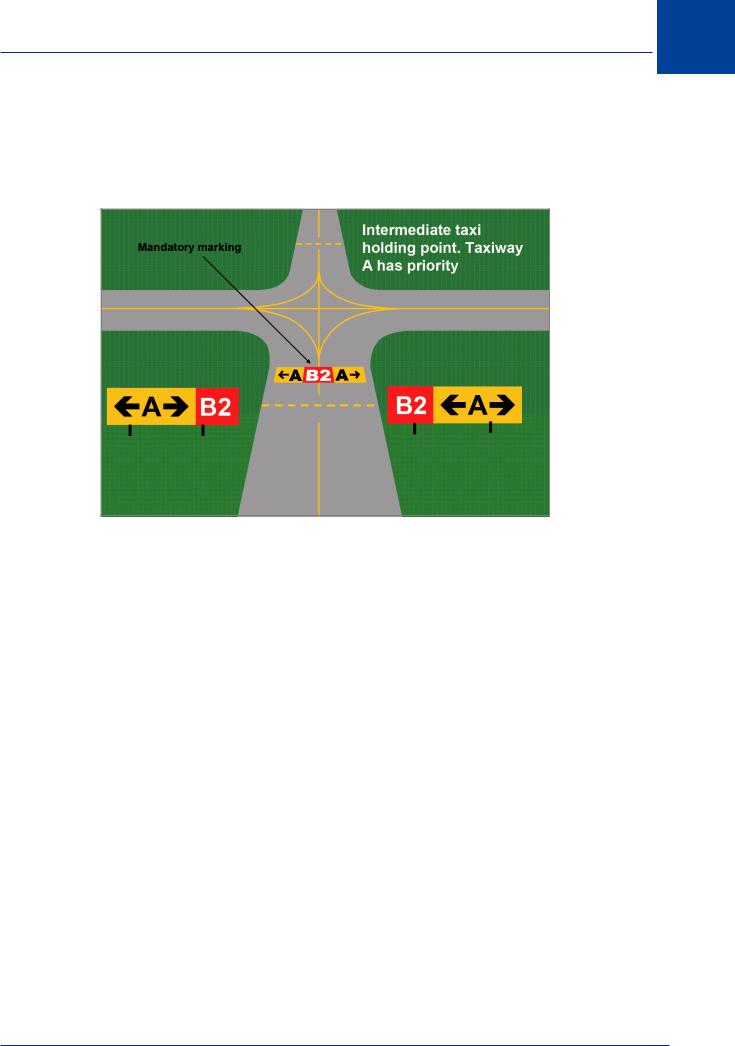
Aerodromes -Visual Aids, Markings and Signs 20
20.43 Taxiway Designators. Taxiways are identified by a designator comprising a letter(s) or a combination of a letter(s) followed by a number. When designating taxiways, the use of the letters I, O or X and the use of words such as inner and outer should be avoided wherever possible to avoid confusion with the numerals 1, 0 and closed marking. The use of numbers alone on the manoeuvring area is reserved for the designation of runways.
|
Figure 20.20 |
|
|
20.44 |
Aircraft Stand Identification Signs. An aircraft stand identification marking (see |
|
|
paragraph 20.55) should be supplemented with a sign where feasible. The sign should be |
|
||
located so as to be clearly visible from the cockpit of an aircraft prior to entering the stand. The |
|
||
sign consists of an inscription in black on a yellow background. Alternatively in Europe this may |
|
||
be white on a blue background. |
|
||
20.45 Road-Holding Position Signs. Road-holding position signs are provided at all road |
|
||
entrances to runways. The road-holding position sign is to be located 1.5 m from the edge of |
|
||
20 |
|||
the road (left or right as appropriate to the local traffic regulations) at the holding position. |
|||
|
|||
A road-holding position marking sign consists of an inscription in white on a red background. |
Signs |
||
If the sign is intended for night use, it is to be reflective or illuminated. The inscription on a |
|||
and |
|||
road-holding position sign is to be in the national language, must conform to the local traffic |
|||
MarkingsAids, |
|||
regulations and include a requirement to stop; a requirement to obtain an ATC clearance; and |
|||
|
|||
the location designator. |
|
||
20.46 Illumination of Signs. Signs must be illuminated when intended for use: |
- Visual |
||
a. |
in RVR conditions less than 800 metres |
||
b. |
at night in association with instrument runways |
Aerodromes |
|
|
|||
c. |
at night in association with non-instrument runways where the code number is 3 or 4 |
|
|
409
